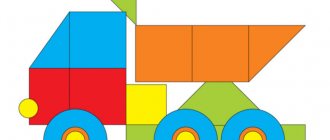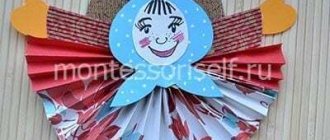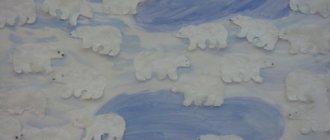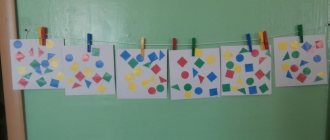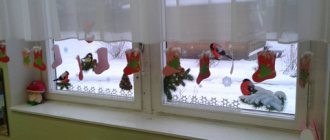Guidelines. Decorative drawing in the middle group.
Author: Kochetkova Evgeniya Sergeevna Methodological recommendations. Decorative drawing in the middle group.
Continuing to introduce children to book illustration, folk arts and crafts, and small-form sculpture, the teacher develops their interest in works of fine art and emotional activity.
During the year, children should be introduced to folk toys (Dymkovo and Filimonovskaya, with ceramic products). The teacher must arouse students’ interest in these works and teach them to consider them. First of all, preschoolers are introduced to local handicrafts. To get acquainted with folk decorative art, you can use techniques such as playing with folk toys and sculptures of small forms when adding them to a group, examining products with children, and involving children in choosing where to place them. After examining, children sculpt birds and animals according to the type of folk toys, learn to make patterns using dots, strokes, circles, rings, and stripes of different sizes, modeled on the Dymkovo and Filimonov toys.
In the middle group, from the beginning of the year, decorative drawing is being introduced based on children’s acquaintance with folk arts and crafts (Dymkovo, Filimonovskaya, Kargopolskaya, Kalininskaya clay toys, ceramic dishes). You should use artistic crafts of the area that are close and accessible to the child for perception and reproduction.
When examining objects of folk art with students, the teacher teaches them to see and identify elements of the pattern: strokes, dots, rings, circles, straight lines.
Each type of folk art has its own combinations of colors and shades. The teacher should show this when examining, draw the children’s attention to the variety of colors. For example, the Dymkovo toy uses colors such as red, yellow, blue, green, etc., which stand out brightly against a white background; The pattern contains black color - small dots and dashes. Decorating large elements. The teacher explains that the beauty of a pattern depends on the repetition of the same elements of the same color.
Children learn to make symmetrical patterns on paper of different shapes: stripes, squares, rosettes, circles. In the second younger group, preschoolers made appliqué patterns on these forms. The new form - a rosette - is close to a square, a circle in that the corners (petals) and the middle are also decorated here.
To make the lessons more effective, it is better to connect the design of the pattern with the decoration of the item. So, children decorate the path - a stripe, the tablecloth - a square plate, the rosette - a circle, they paint the fabric on their mother’s dress, etc.
The success of teaching decorative drawing largely depends on how interesting the teacher organizes children’s perception of products, whether he uses play techniques, surprise moments, etc.
Based on one of the types of folk art, 2–3 classes can be conducted. For example, preschoolers paint a path (stripe) for a Dymkovo doll, using one of the elements of the pattern - circles, decorated in the same way as the children saw on the Dymkovo toy. Then you can suggest decorating the strip with two elements - circles and strokes or ovals, alternating them. And enter dashes and dots into them. From the first days of classes, the teacher teaches children to choose a color for each element, advising which paints are best to use in accordance with the color of the painting. Children decorate a square, rosette, circle, making a pattern for a napkin, tablecloth, saucer for a Dymkovo doll.
You can give the children the task of making a pattern on the “fabric” for the Dymkovo doll’s skirt, using the pattern that they were looking at. Preschoolers learn to alternate stripes (lines) wide and narrow, lines and circles, lines and ovals (strokes). It is necessary to give the child the opportunity to choose the color for the elements of the pattern and decorations. The pattern is drawn up on half a landscape sheet and the silhouette of a Dymkovo doll is prepared to fit this size, with slits made in its skirt. By inserting the drawing into the slots, the child dresses the doll, choosing the brightest skirt, decorated with even stripes, rows of circles, etc. Silhouettes of Filimonov toys can be used in a similar way. This technique arouses children’s interest in drawing, and when dressing a doll, they better understand the purpose of the pattern, its rhythm, the most beautiful combinations of colors, large and small elements.
During the year, we should conduct several classes according to the plan, in which each child chooses a paper shape, pattern elements, color and creates his own pattern.
In addition, when depicting objects, it is sometimes advisable to decorate them (dress, apron for a doll, etc.); give tasks to draw a fairy-tale house, a magic fish, a bird, focusing on the skills that preschoolers acquired in decorative drawing classes.
Literature.
L. V. Rusakova To the “Program of education and training in kindergarten” Methodological recommendations Moscow “Enlightenment” 1986
Komarova T. Visual activities of children in kindergarten. - M.: MaRT, 2009
Lykova I. A. Visual activities in kindergarten - M.: Sfera, 2011.
Author:
Kochetkova Evgenia Sergeevna
Guidelines. Decorative drawing in the middle group.
Continuing to introduce children to book illustration, folk arts and crafts, and small-form sculpture, the teacher develops their interest in works of fine art and emotional activity.
During the year, children should be introduced to folk toys (Dymkovo and Filimonovskaya, with ceramic products). The teacher must arouse students’ interest in these works and teach them to consider them. First of all, preschoolers are introduced to local handicrafts. To get acquainted with folk decorative art, you can use techniques such as playing with folk toys and sculptures of small forms when adding them to a group, examining products with children, and involving children in choosing where to place them. After examining, children sculpt birds and animals according to the type of folk toys, learn to make patterns using dots, strokes, circles, rings, and stripes of different sizes, modeled on the Dymkovo and Filimonov toys.
In the middle group, from the beginning of the year, decorative drawing is being introduced based on children’s acquaintance with folk arts and crafts (Dymkovo, Filimonovskaya, Kargopolskaya, Kalininskaya clay toys, ceramic dishes). You should use artistic crafts of the area that are close and accessible to the child for perception and reproduction.
When examining objects of folk art with students, the teacher teaches them to see and identify elements of the pattern: strokes, dots, rings, circles, straight lines.
Each type of folk art has its own combinations of colors and shades. The teacher should show this when examining, draw the children’s attention to the variety of colors. For example, the Dymkovo toy uses colors such as red, yellow, blue, green, etc., which stand out brightly against a white background; The pattern contains black color - small dots and dashes. Decorating large elements. The teacher explains that the beauty of a pattern depends on the repetition of the same elements of the same color.
Children learn to make symmetrical patterns on paper of different shapes: stripes, squares, rosettes, circles. In the second younger group, preschoolers made appliqué patterns on these forms. The new form - a rosette - is close to a square, a circle in that the corners (petals) and the middle are also decorated here.
To make the lessons more effective, it is better to connect the design of the pattern with the decoration of the item. So, children decorate the path - a stripe, the tablecloth - a square plate, the rosette - a circle, they paint the fabric on their mother’s dress, etc.
The success of teaching decorative drawing largely depends on how interesting the teacher organizes children’s perception of products, whether he uses play techniques, surprise moments, etc.
Based on one of the types of folk art, 2–3 classes can be conducted. For example, preschoolers paint a path (stripe) for a Dymkovo doll, using one of the elements of the pattern - circles, decorated in the same way as the children saw on the Dymkovo toy. Then you can suggest decorating the strip with two elements - circles and strokes or ovals, alternating them. And enter dashes and dots into them. From the first days of classes, the teacher teaches children to choose a color for each element, advising which paints are best to use in accordance with the color of the painting. Children decorate a square, rosette, circle, making a pattern for a napkin, tablecloth, saucer for a Dymkovo doll.
You can give the children the task of making a pattern on the “fabric” for the Dymkovo doll’s skirt, using the pattern that they were looking at. Preschoolers learn to alternate stripes (lines) wide and narrow, lines and circles, lines and ovals (strokes). It is necessary to give the child the opportunity to choose the color for the elements of the pattern and decorations. The pattern is drawn up on half a landscape sheet and the silhouette of a Dymkovo doll is prepared to fit this size, with slits made in its skirt. By inserting the drawing into the slots, the child dresses the doll, choosing the brightest skirt, decorated with even stripes, rows of circles, etc. Silhouettes of Filimonov toys can be used in a similar way. This technique arouses children’s interest in drawing, and when dressing a doll, they better understand the purpose of the pattern, its rhythm, the most beautiful combinations of colors, large and small elements.
During the year, we should conduct several classes according to the plan, in which each child chooses a paper shape, pattern elements, color and creates his own pattern.
In addition, when depicting objects, it is sometimes advisable to decorate them (dress, apron for a doll, etc.); give tasks to draw a fairy-tale house, a magic fish, a bird, focusing on the skills that preschoolers acquired in decorative drawing classes.
Literature.
L. V. Rusakova To the “Program of education and training in kindergarten” Methodological recommendations Moscow “Enlightenment” 1986
Komarova T. Visual activities of children in kindergarten. - M.: MaRT, 2009
Lykova I. A. Visual activities in kindergarten - M.: Sfera, 2011.
comments powered by HyperComments
Next riddle
Strengthen children's ability to correlate flat geometric shapes with the shape of parts of objects, create an image from ready-made parts, and independently cut out small parts.
| The attachment | Size |
| konspekt_zanyatiya_po_applikatsii_v_sredney_gruppe.doc | 31.5 KB |
On the topic: methodological developments, presentations and notes
Summary of a speech therapy lesson for a teacher - speech therapist S. V. Turovskaya. Summary of the lesson "Sound "U""
Topic. Sound U. Purpose. Strengthen the skills of clear pronunciation of sound. Educational objectives: 1. Introduce children to sound.
Lesson notes in mathematics Lesson notes in mathematics in the middle group Topic: Plan (travel map) Program tasks: Develop the ability to navigate according to an elementary plan, correctly determine the relative position of objects in the
Lesson notes in mathematicsLesson notes in mathematics in the middle group Topic: Plan (travel map) Program objectives: Develop the ability to navigate according to an elementary plan, correctly.
Lesson notes Lessons on speech development Notes of the final lesson on speech development “Visiting grandma”
Lesson notesClasses on speech developmentLessons of the final lesson on speech development “Visiting grandma.”
Summary of an open lesson in a preparatory group for school Summary of an open lesson in a preparatory group for school Summary of a lesson in a preparatory group of a teacher-psychologist with hearing-impaired children
Date: February 21, 2012 Participants: children of the preparatory group Conducted by: educational psychologist Panova M.M. Purpose: to promote formation.
Notes for a comprehensive lesson in mathematics and design in the second junior group Notes for a comprehensive lesson in mathematics and design in the second junior group Notes for classes
Introduce children to number and figure 6. Improve counting skills and comparison of subject aggregates. Form children’s ability to distinguish between the concepts of yesterday, today, tomorrow. Consolidate knowledge about geome.
Lesson summary “Travel to Africa. How to help a boa constrictor? outline of a lesson in mathematics (preparatory group) on the topic outline of a lesson on the world around us (preparatory group)
Lesson summary “Travel to Africa. How to help a boa constrictor?” Program content: 1. Educational: learn to use a conventional measure when determining the size of objects.
1. Lesson notes on the surrounding world (01/11/2021) 2. Math lesson notes (01/13/2021) 3. Speech development notes (01/15/2021) 4. Drawing notes (01/19/2021)
1. The surrounding world Topic: Winter sports. 2. mathematics Schitariki-Smeshariki. topic: counting from 1 to 53. speech development, conversation with a puppet theater based on the fairy tale Rukavichka.4. drawing theme: Winter.
Questions for children based on their drawings
You should not finish the lesson immediately after drawing. Children should be encouraged to talk about what and why they drew. You can give the guys a little time to create a full-fledged history of their bird, give it a name, come up with a breed if one does not exist.
You can also ask the children whose bird is the most beautiful and why. But with this task you need to be very careful, because you cannot single out anyone, and you should not deprive them of attention. Some can be praised for their drawing technique and accuracy, some for their unusual story, and some for their successful combination of colors and realism.
This lesson will introduce children not only to a whole section of wildlife, but will also help develop their creative and social skills. For these reasons, art lessons should be taught as early as possible so that children from an early age are introduced to the broad concept of “beauty” and learn to work in a team.
Preliminary work with children, discussion of the topic
Before moving on to the main part of the task, you should make sure that the children have a complete understanding of birds. To do this, you need to show them these animals live. If it is spring or summer at the time of the lesson, then you can go outside, because birds are especially active during this period. If it’s winter, when many birds go south, you have to be content with pictures or stuffed animals. You should also tell children about different types of birds, among which are:
- Migratory;
- wintering;
- domestic.
It is also necessary to talk about the diet of birds: mosquitoes and other insects, seeds and fruits. To captivate children even more, you can tell children fairy tales about these animals, ask them to guess riddles about birds, and also talk about interesting expressions like “small bird.”
Physical education minute
To prevent children from getting bored, physical education sessions must be held once an hour. If the room is large and spacious enough, then you can perform several dance moves to funny short songs.
Note! You can find songs about birds and invite children to perform flapping movements to the music, similar to flapping their wings. If the class is not very large, then you can do eye exercises.
Physical education for birds"
